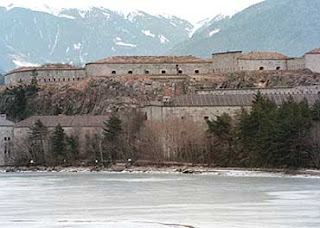The Briefing

Outlook posts Arundhati Roy's latest writting.
My greetings. I'm sorry I'm not here with you today but perhaps it's just as well. In times such as these, it's best not to reveal ourselves completely, not even to each other.
If you step over the line and into the circle, you may be able to hear better. Mind the chalk on your shoes.
I know many of you have travelled great distances to be here. Have you seen all there is to see? The pillbox batteries, the ovens, the ammunition depots with cavity floors? Did you visit the workers' mass grave? Have you studied the plans carefully? Would you say that it's beautiful, this fort? They say it sits astride the mountains like a defiant lion.
Even though this fort has never been attacked, think of how its creators must have lived the idea of being attacked, waited for it. Is this what this fort is...a testament to trepidation?
I confess I've never seen it. The guidebook says it
wasn't built for beauty. But beauty can arrive uninvited, can it not? It can fall upon things unexpectedly, like sunlight stealing through a chink in the curtains. Ah, but then this is the fort with no chinks in its curtains, the fort that has never been attacked. Does this mean its
forbidding walls have thwarted even Beauty and sent it on its way?
Beauty. We could go on about it all day and all night long. What is it? What is it not? Who has the right to decide? Who are the world's real curators, or should we say the real world's curators? What is the real world? Are things we cannot imagine, measure, analyse, represent and reproduce real? Do they exist? Do they live in the recesses of our minds in a fort that has never been attacked? When our imaginations fail, will the world fail too? How will we ever know?
How big is it, this fort that may or may not be beautiful? They say it is the biggest fort ever built in the high mountains.
Gigantic, you say? Gigantic makes things a little difficult for us. Shall we begin by mapping its vulnerabilities? Even though it has never been attacked (or so they say), think of how its creators must have lived and relived the idea of being attacked. They must have waited to be attacked. They must have dreamt of being attacked.
Remember Macbeth? "Who can impress the forest, bid the tree unfix his earthbound root," he asked. He was dead wrong. Trees have unfixed their roots and are on the move.
They must have placed themselves in the minds and hearts of their enemies until they could barely tell themselves apart from those they feared so deeply. Until they no longer knew the difference between terror and desire. And then, from that knothole of tormented love, they must have imagined attacks from every conceivable direction with such precision and cunning as to render them almost real. How else could they have built a fortification like this? Fear must have shaped it; dread must be embedded in its very grain. Is that what this fort really is? A fragile testament to trepidation, to apprehension, to an imagination under siege?
It was built-and I quote its chief chronicler-to store everything that ought to be defended at all costs. Unquote. That's saying something. What did they store here comrades? What did they defend?
Weapons. Gold. Civilisation itself. Or so the guidebook says.
And now, in Europe's time of peace and plenty, it is being used to showcase the transcendent purpose, or, if you wish, the sublime purposelessness, of civilisation's highest aspiration: Art. These days, I'm told, Art is Gold.
I hope you have bought the catalogue. You must. For appearances' sake at least.
As you know, the chances are that there's gold in this Fort. Real gold. Hidden gold. Most of it has been removed, some of it stolen, but a good amount is said to still remain. Everyone's looking for it, knocking on walls, digging up graves. Their urgency must be palpable to you.
They know there's gold in the fort. They also know there's no snow on the mountains. They want the gold to buy some snow.
Those of you who are from here-you must know about the Snow Wars.

Comments